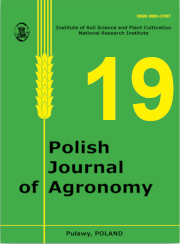THE EFFECT OF WEED CONTROL METHOD ON WEED INFESTATION AND YIELD OF BUCKWHEAT
Main Article Content
Abstract
Buckwheat is characterized by a high level of competitiveness against weeds but under certain conditions it can be strongly infested by weeds. A three-year study (2010–2012) was conducted as a field experiment in Experimental Station IUNG-PIB Osiny, the objective of which was to compare the biological method of weed control in buckwheat that relied on the use of winter rye as a catch-crop com- bined with mechanical weeding and chemical method (linuron-based herbicide). The herbicide-based control was found superior to the bi- ological method in terms of efficacy but it involved some damage to buckwheat plants. The reduction of weed infestation rate achieved by using rye as a catch crop varied from 28 to 92%, depending on weed species. In this treatment the growth of Viola arvensis, Anthemis ar- vensis and Polygonum convolvulus was the most strongly suppressed. The yield of seeds from the latter treatment was about 40% higher than that from the former.
Article Details

This work is licensed under a Creative Commons Attribution-ShareAlike 4.0 International License.
The author grants the editorial staff of the Polish Journal of Agronomy (abbreviated as PJA) a non-exclusive and royalty-free license to use the author's copyright in the paper/printed and electronic versions of his/her work published in PJA in Poland and abroad, in whole or in any part, including placing the work in electronic databases/databases locally or available on the Internet, for an unlimited period of time in the fields of exploitation specified in article 50 of the Copyright and Related Rights Act.
Manuscripts published in Polish Journal of Agronomy are available under a Creative Commons Attribution-ShareAlike 4.0 (CC-BY-SA) license.

